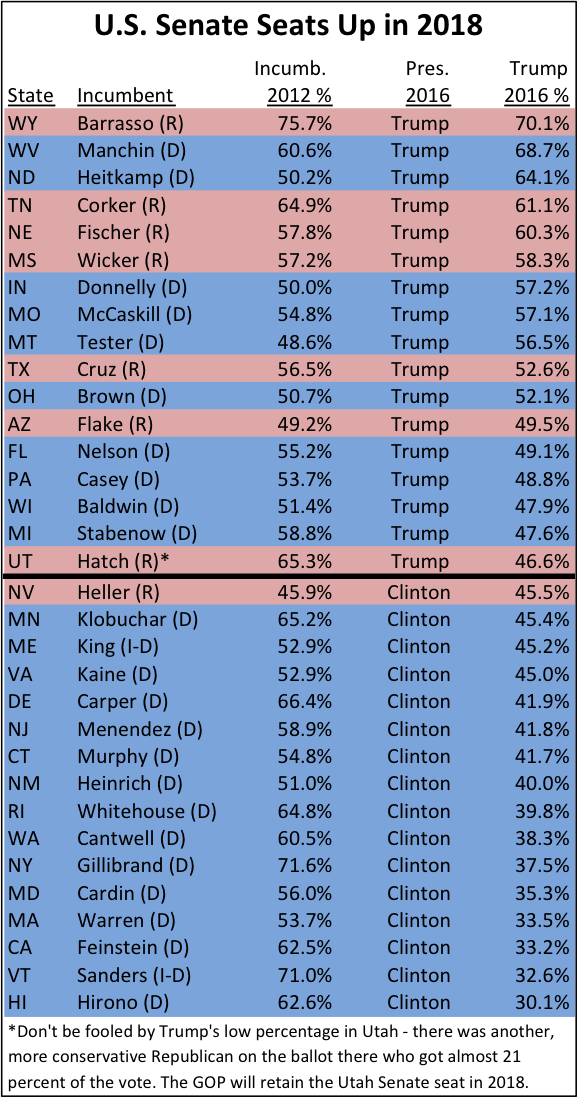November 16, 2016
The surprise election of Donald J. Trump to become the 45th President of the United States has thrown the transportation stakeholder community into an uproar, with no one knowing what to expect over the next four years. The Trump transition office now has its own website, greatagain.gov, to solicit resumes and make announcements, but there is no personnel directory to indicate who is working on the transition team aside from the few top individuals. But there have been no public announcements as to the programmatic teams.
Persons who have been leading the transition team on transportation and infrastructure issues include Martin Whitmer, former Deputy Chief of Staff to Secretary of Transportation Norman Mineta, and Shirley Ybarra, who was Virginia Secretary of Transportation from 1994 to 1998 and then was a longtime policy analyst at the libertarian-leaning think tank the Reason Foundation. (Disclosure: Whitmer is a member of the Eno Center’s Board of Directors.)
The first question is – who becomes the next U.S. Secretary of Transportation?
In the immediate aftermath of the election, there was a lot of speculation that former Federal Transit Administrator James Simpson would be a top candidate for the “S-1” job because he had been New Jersey Governor Chris Christie’s state DOT chief from 2010 to 2014 and because Christie was running the transition and helping pick Cabinet contenders.
But Christie was removed as head of the transition last Friday and his allies were purged over the next few days, making Simpson’s selection much less likely.
The only other name to pop up in the conversation is that of former House Transportation and Infrastructure Committee chairman John Mica (R-FL), who lost his re-election bid last week. But all the talk seems to be coming from Mica, who is actively promoting himself for the job, and it is not clear if there is any pro-Mica constituency in Trumpland. (Ed. Note: There is one vacancy on the Amtrak Board of Directors that is available for President Trump to fill. Mica’s love for Amtrak is legendary.)
In the last few Administrations, the top DOT job was much sought-after and easy to fill, which meant that it was held out until the very end of the process (and in the last two Administrations, the initial SecDOT was a member of the opposition political party).
There are 20 jobs at or around the U.S. Department of Transportation subject to Senate confirmation for which President Trump can nominate candidates on or after January 20:
- Secretary of Transportation
- Deputy Secretary of Transportation
- Under Secretary for Policy
- General Counsel
- Assistant Secretary for Transportation Policy
- Assistant Secretary for Aviation and International Affairs
- Assistant Secretary for Research and Technology
- Assistant Secretary for Government Affairs
- Chief Financial Officer*
- FHWA Administrator
- FMCSA Administrator
- FRA Administrator
- FTA Administrator
- MARAD Administrator
- NHTSA Administrator
- PHMSA Administrator
- 3 seats on the Surface Transportation Board (out of 5)
- 1 seat on the Amtrak Board of Directors (out of 8)
The FAA Administrator now has a fixed five-year term and Administrator Huerta’s term does not expire until January 1, 2018.
The DOT Inspector General serves during “good behavior.” If he should resign, the President would nominate a replacement.
*A 2012 reform law removed the Assistant Secretary of Transportation for Budget and Programs from the need for Senate confirmation. But since that Assistant Secretary also serves as DOT’s Chief Financial Officer, a separate law still requires that all departmental CFOs be confirmed by the Senate. The reform law also removed the Senate confirmation requirement for the FAA Deputy Administrator and the St. Lawrence Seaway Development Corporation Administrator.
Beyond the legions of personnel decisions that the transition team will have to make, there is the matter of policy. Trump’s campaign did not put forward official policy papers that were nearly as detailed as those of the Clinton campaign. The longest list of infrastructure agenda items is on the Trump campaign website here.
The only related item on the transition team webpage is this blurb which says “Americans deserve a reliable and efficient transportation network and the Trump Administration seeks to invest $550 billion to ensure we can export our goods and move our people faster and safer. We will harness technology and make smarter decisions on how we build and utilize our infrastructure. Our roads, bridges, airports, transit systems and ports will be the envy of the world and enhance the lives of all Americans. We will build the roads, highways, bridges, tunnels, airports, and railways of tomorrow.”
Financial markets are definitely assuming that Trump will be successful in putting a lot of infrastructure money out there fairly quickly. Since Election night, the S&P 500 has gone up 1.9 percent, but infrastructure-related stocks have gone up by significantly more than that – some big construction and engineering companies have seen their stock increase by more than 35 percent in one week.
Trump has also taken pains to emphasize domestic job creation as a focus of infrastructure spending. Together with his anti-globalization agenda, we can expect stronger domestic content rules. Trump’s plan makes a point of emphasizing that his plan would revitalize the domestic steel industry by using only American steel in infrastructure projects. The plan does not address the Buy America requirements for components other than steel, but Trump’s overall sentiments mean that the California bullet train’s recent request for a massive Buy America waiver for 19 different components of the trainsets and for the Federal Railroad Administration’s “concurrence that the steel comprising these components does not have to be sourced in the United States” is poorly timed to say the least. The comment period on the request closes November 28, so in theory, the Obama Administration could issue the waiver before President Trump takes office, but it sure sounds like a Trump Administration won’t be giving out very many BA waivers in the future.
(Hat tip to Ralph Vartabedian’s article in the Los Angeles Times for pointing this out.)
Of the many ironies inherent in the recent election results, one is that many of the most conservative Republicans in Congress – who hate spending money on anything domestic – nonetheless wholeheartedly backed a candidate who took pride in promising to spend “twice as much” money on infrastructure as Hillary Clinton.
His success in getting Congressional Republicans to break open the piggy bank is not completely certain but seems likely. Ever since Ronald Reagan, Republicans in Congress gave the message that they stood for three things, in this order:
- Low taxes.
- Robust spending on national defense.
- Lower deficits and less federal debt.
The third item – deficits and debt – always was a distant third, and the desire for lower taxes and more defense spending always took precedence. One of the real accomplishments of the Tea Party post-2010 was moving deficit and debt considerations from #3 to #2 amongst many conservatives in Congress for a brief period of time. But the agenda espoused by the Trump campaign clearly moves deficit and debt issues back to a distant third place, and anti-deficit groups are already warning that Trump’s agenda threatens long-term fiscal solvency.
To the extent that Republicans in Congress are still afraid of voting for massive increases in federal spending, one option could be to leverage the use of non-federal money. Two economic advisors to Trump published a paper last month calling for $1 trillion in infrastructure investment using repatriated corporate overseas earnings, public-private partnerships, and the massive issuance of bonds. (See the article elsewhere in this week’s issue on the 2018 budget process for a discussion of the debt ceiling vote that will take place by next summer – it might have a lot to do with federal infrastructure bonding.)
The Trump transition website, by the way, still uses the $550 billion figure for the infrastructure spending total, not the $1 trillion total.
The economist’s paper also is fiercely critical of proposals to create a national infrastructure bank. Trump’s own website criticized Secretary Clinton for proposing “a massive $275 billion tax increase on American businesses to help fund an “infrastructure bank” that is controlled by politicians and bureaucrats in Washington DC.” (Only $25 billion of the Clinton proposal was for an infrastructure bank, by the way.) But today, a key Trump economic adviser told reporters that the Trump transition team was exploring the creation of an infrastructure bank.
The change of opinion may be due to the fact that infrastructure banks leverage tremendous amounts of federal money, very little of which actually goes on record as part of the federal budget. (See ETW’s two-part series on infrastructure banks from three months ago – the history of I-Bank proposals and the issues Congress would face in setting one up.)
Another item in the Trump infrastructure plan is to “Work with Congress to modernize our airports and air traffic control systems, end long wait times, and reform the FAA and TSA, while also ensuring that American travelers are safe from terrorism and other threats.”
This gives hope to House Transportation and Infrastructure Committee chairman Bill Shuster (R-PA), who hopes to revitalize his proposal to spin off air traffic control from the FAA to a private non-profit corporation. Active support from the Trump Administration, if forthcoming, could at least get Shuster’s bill to the floor of the House (it died between committee and the House floor this year). Ybarra’s presence on the transition team is a good sign in this regard, as the Reason Foundation has been at the forefront of “privatization” activities for decades.
President Trump should find no shortage of Democrats to work with him on infrastructure legislation. And even on more controversial issues, the nature of the Senate seats up for grabs in 2018 means that a significant number of Democratic Senators will feel pressure to cooperate with Trump to some degree.
The table at right shows each Senate seat up in 2018, how the incumbent fared in their last election, whether the state was carried by Trump or Clinton, and by what margin. Ten Senators up for re-election in two years represent Trump states versus just one Republican representing a Clinton state.
And in some of those Trump states, Trump won by blowout margins (68.7 percent of the vote in West Virginia, 64.1 percent of the vote in North Dakota). Even on some issues opposed by Senate Democratic leaders, on the less-controversial ones,it is not impossible that the Trump agenda can cobble together the 60 votes needed to break filibusters from time to time.




